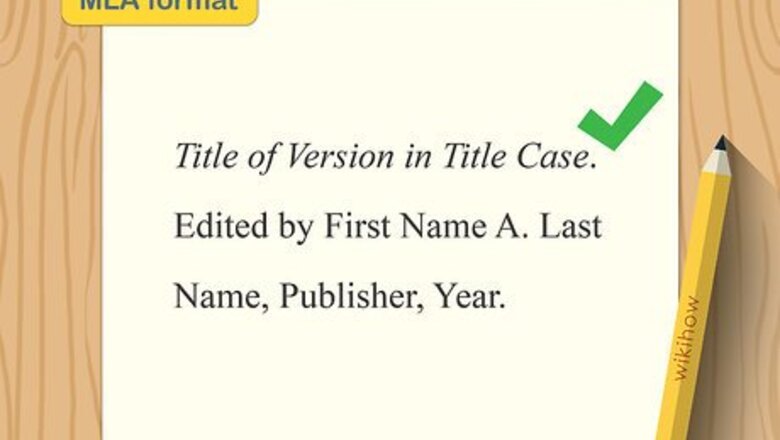
views
X
Research source
MLA
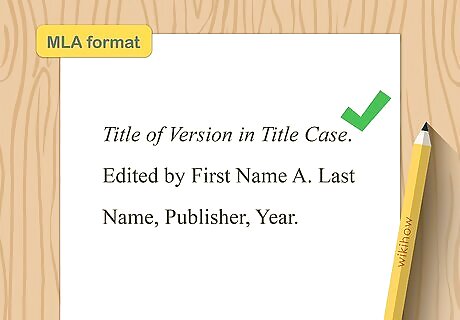
Start your Works Cited entry with the version you used. Type the title of the specific version of the Bible that you used in italics. Use title case, capitalizing the first word and all nouns, pronouns, adjectives, adverbs, and verbs. Place a period at the end of the title. Example: The New Oxford Annotated Bible.Variation: If the version you used has a specific author listed, lead with the author's name, then provide the title of the version. For example: Peterson, Eugene H. The Message: The Bible in Contemporary Language.
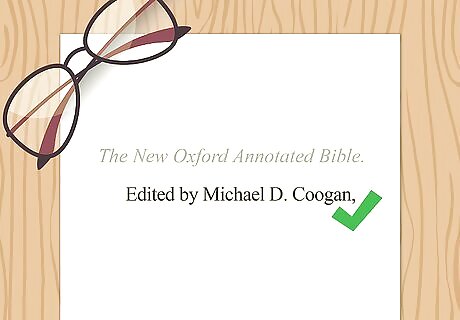
Include the editor's name if listed. If the version you used has a named editor, you will likely find their name on the title page of the Bible. Type the words "Edited by" in regular font, followed by the editor's name in first name-last name format. Place a comma after the editor's name. Example: The New Oxford Annotated Bible. Edited by Michael D. Coogan,
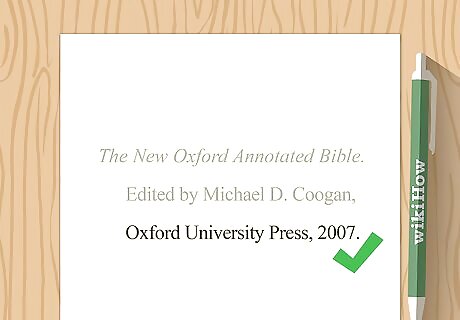
Close with publication information. Provide the name of the publisher of the version followed by a comma. Then type the year that version was published. Place a period after the year to end your Works Cited entry. Example: The New Oxford Annotated Bible. Edited by Michael D. Coogan, Oxford University Press, 2007. MLA Works Cited Entry Format: Title of Version in Title Case. Edited by First Name A. Last Name, Publisher, Year.

List the URL and your date of access for online Bibles. If you accessed an online version of the Bible, your Works Cited entry includes the name of the website as the publisher along with the URL for the website. Leave the "http://" part off of the URL. Place a period at the end of the URL, then type the word "Accessed" followed by the date you last accessed the source in day-month-year format. Abbreviate the names of months with more than 4 letters. Place a period at the end of the year. Example: New International Version. Bible Gateway, www.biblegateway.com. Accessed 29 Jan. 2019.

List the version in your first in-text citation. The first time you reference the Bible in your paper, add a parenthetical citation at the end of the sentence, inside the closing punctuation. Type the name of the version of the Bible you used in italics, followed by a comma. Then provide the book, chapter, and verse in regular font. Abbreviate the names of books as shown in the MLA handbook. Separate chapter and verse with a period. Example: (New International Version, Rom. 12.2).

Provide only book, chapter, and verse for subsequent citations. As long as you only used one version of the Bible, you don't need to include the version in your parenthetical citations after listing it once. Simply provide the name of the book, chapter, and verse. In-text citations are designed to point your readers to the full citation listed in your Works Cited. If you used several different versions of the Bible as sources, let your readers know when you've switched to a different version by adding the name of the version to the parenthetical citation.
APA
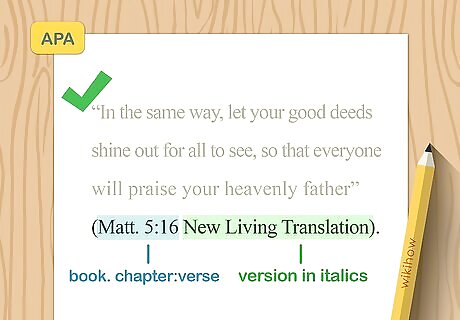
Identify the version you used in your first parenthetical citation. APA doesn't require a full citation in your reference list at the end of your paper. At the end of any sentence in which you've referenced the Bible, place a parenthetical citation with the book, chapter, and verse followed by the name of the version in regular font. Separate chapter and verse with a colon. Abbreviate the names of the books of the Bible following the abbreviations listed in the APA publication manual. For example: "In the same way, let your good deeds shine out for all to see, so that everyone will praise your heavenly father" (Matt. 5:16 New Living Translation).
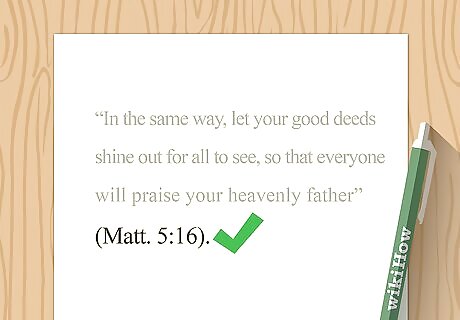
Include only the book, chapter, and verse in subsequent in-text citations. As long as you're using the same version of the Bible, you don't have to continue to list the name of the version in your parenthetical citations. Simply list the book, chapter, and verse. For example: "In the same way, let your good deeds shine out for all to see, so that everyone will praise your heavenly father" (Matt. 5:16). If you switch to a different version, for example, if you were comparing translations, then you would list the different version in the parenthetical citation.Tip: If you're using the same version and you list the book, chapter, and verse in the body of your paper, no parenthetical citation is needed.

Include a reference list entry if required by your editor or instructor. Although the APA doesn't require a full citation in your reference list, your editor or instructor may want one. Ask what they prefer, or when in doubt include reference list entries, particularly if you are comparing several versions. Follow the format for citing a book. For example, your reference list entry might look like this: The New Oxford Annotated Bible. (2007). M. D. Coogan (Ed.). Oxford, UK: Oxford University Press.
Chicago/Turabian
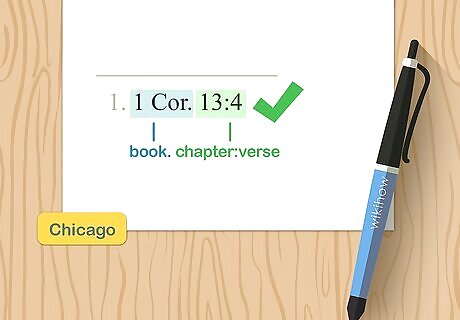
List the book, chapter, and verse in a footnote. Start your footnote with the name of the book, abbreviated using the Chicago abbreviation tables. Add the chapter, followed by a colon, then the verse or range of verses. Example: 1 Cor. 13:4 If you're citing several books or chapters of the same book in the same footnote, separate those citations with a semi-colon. For example: 1 Cor. 13:4; 15:12-29. A list of abbreviations used in Chicago or Turabian style can be found at http://hbl.gcc.libguides.com/BibleAbbrevChicago if you don't have a copy of the manual handy.Tip: Chicago has a list of traditional abbreviations as well as another list of shorter abbreviations. Typically you can use either as long as you use the same one consistently. However, you may want to ask your editor or instructor which they prefer.
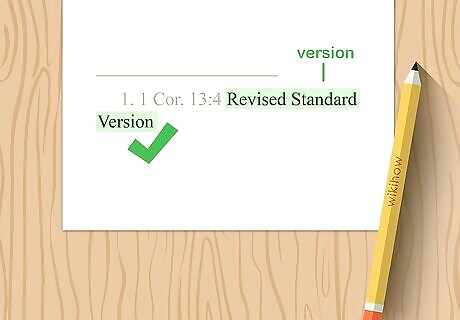
Close your footnote citation with the name of the version you used. In the first footnote you use to cite to the Bible, include the name of the version you used. You can either spell out the full name of the version or use an abbreviation. No period is necessary at the end of your citation. Example: 1 Cor. 13:4 Revised Standard Version After your first footnote, there's no need to add the name of the version unless you switch to a different version, such as if you were comparing translations.
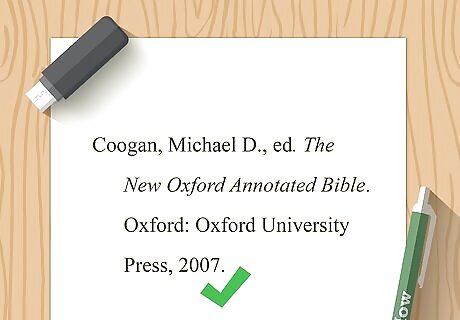
Include an entry in your bibliography if requested by your editor or instructor. Chicago and Turabian don't require a bibliography entry for the Bible. If you do provide a bibliography entry, format it the same way you would for any other book. For example, your bibliography entry might be formatted like this: Coogan, Michael D., ed. The New Oxford Annotated Bible. Oxford: Oxford University Press, 2007.


















Comments
0 comment